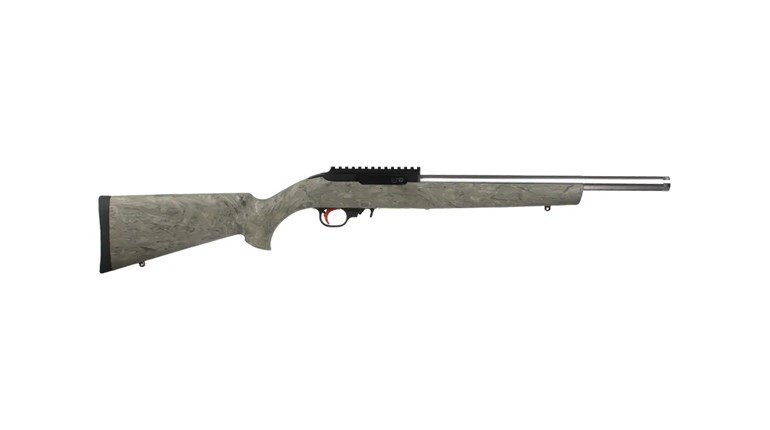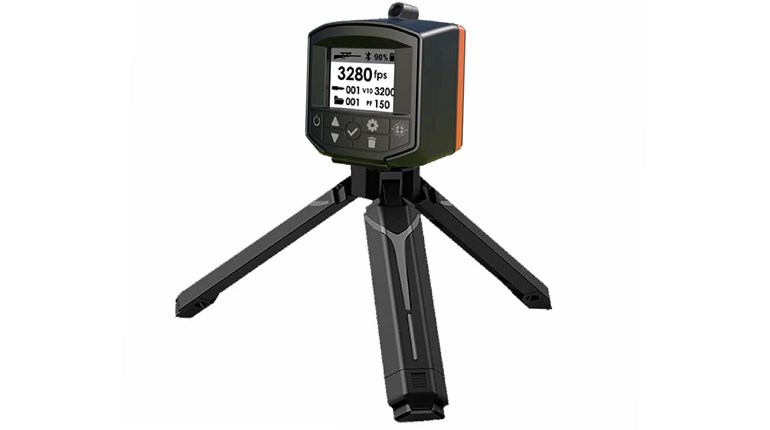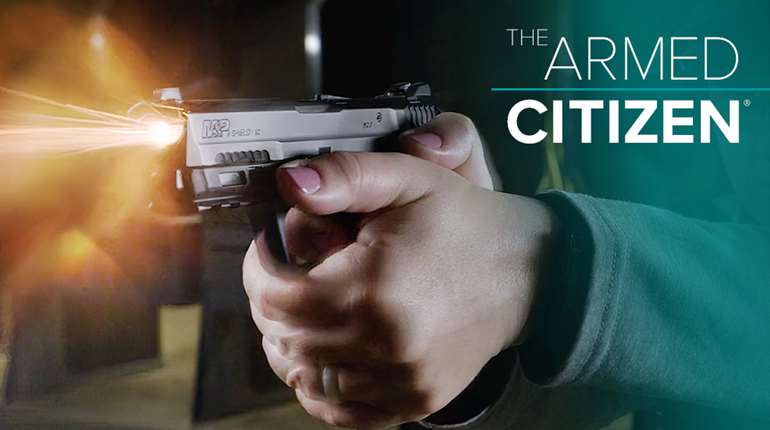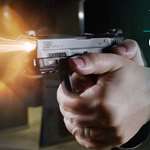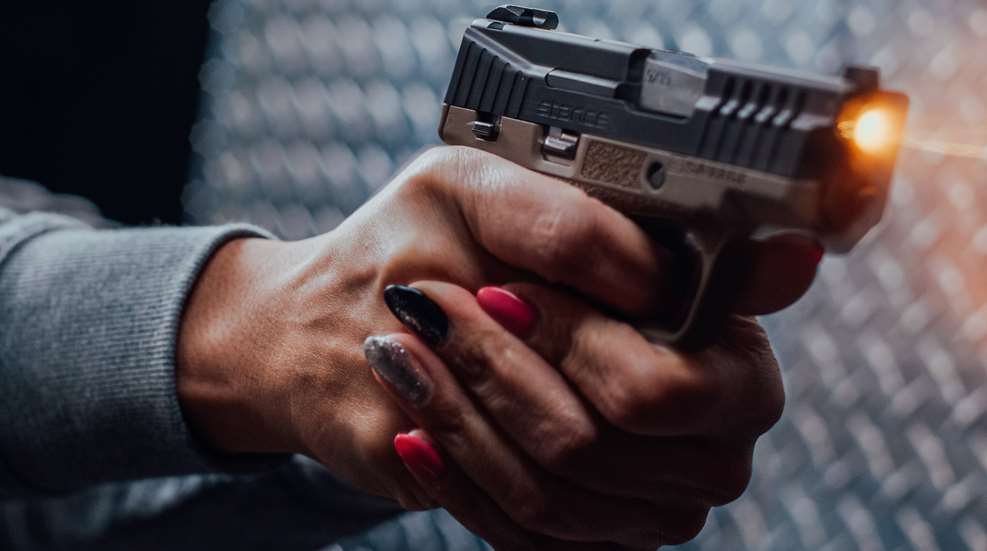
The first question folks often have when stepping up to a shooting bench with a handgun for the first time is, "Will this hurt?" or, "How hard does this thing kick?" Concerns about handgun recoil are perfectly justified for new shooters since it's human nature to steer clear of activities that make us physically uncomfortable. Add in the noise, muzzle flash and what may be wholly unfamiliar surroundings and procedures, and it’s understandable why first-time trigger trippers can feel intimidated.
So what exactly is felt recoil? Why do some handguns kick harder than others, even when they are chambered in the same caliber? And is there any way to get an idea of just how much recoil a pistol or revolver might generate before finding out the hard way?
There's actually an impressive amount of scientific study, data collection and testing that goes into answering these seemingly simple questions. Although it is necessary to rub up against some of the science in order understand the nature of felt recoil, my goal here is to share a set of general principles that can be helpful in guiding firearm and ammunition selection for first time handgun owners and those looking to try something new. This information could be presented in a variety of ways but for this discussion I've opted to break it down into three parts: A closer look at handgun ammunition, how the gun itself affects recoil, and the all important human factor.
Ammunition: Actions & Reactions
Newton's Third Law of Motion states that for every action (or force) in nature there is an equal and opposite reaction. Firearms of all types demonstrate this principle quite effectively. When a handgun cartridge is fired, the resulting action is the bullet being pushed out of the barrel by the high-pressure gases produced from the burning of the gun powder inside of the cartridge case. The opposite reaction of firing the round is the handgun pressing backward into the shooter’s hands with an equal amount of force. This backward shove, or kick, is what we call recoil.
How much recoil a particular cartridge generates depends on how fast the bullet is traveling when it leaves the gun (bullet velocity) and just how much bullet there is (bullet weight). Bullet velocity is a clear indicator of how much pressure was exerted to launch it. Simply stated, if two bullets of the same weight are leaving the barrel of a pistol at different velocities, the bullet that is traveling faster will produce more recoil.
Since it takes more energy to move a heavier object than a lighter one, bullet weight is also an important factor. This means that if two bullets of different weights are fired from the same gun at the same velocity, the heavier of the two bullets will produce more recoil. This is because it takes more energy to get heavy bullets up to speed. And greater bullet energy in one direction means the handgun moving backwards more vigorously, or recoiling, in the other.
Here's how we put all of this information to work. By taking the bullet's weight (measured in grains, gr.) and pumping it through a mathematical formula along with how fast the bullet was flying along when it left the gun (muzzle velocity, measured in feet per second, f.p.s.) you can get what is called the bullet’s muzzle energy (measured in foot-pounds, or ft.-lbs.). Generally speaking, larger muzzle energy numbers mean increased levels of felt recoil.
Here is a table taken from an article about using .22 LR handguns for self-defense. It shows seven calibers fired from handguns with different weights, barrel lengths and grip sizes (more on that in a minute) and the range of bullet energy levels they produced:
.22 LR: 79 to 113 ft.-lbs. (Taurus TX22, 4.00" Barrel)
.380 ACP: 140 to 180 ft.-lbs. (Walther CCP M22, 3.54" Barrel)
.38 Spl: 296 ft.-lbs. (Ruger SP101, 2" Barrel)
9 mm: 282 to 355 ft.-lbs. (Girsan MC28, 4.00" Barrel)
.40 S&W: 402 to 472 ft.-lbs. (SIG Sauer P226, 4.40" Barrel)
.45 ACP: 360 to 434 ft.-lbs. (Girsan MC1911 ME, 5" Barrel)
.357 Mag.: 410 to 624 ft.-lbs. (Ruger SP101, 2" Barrel)
Without any additional background or information, the energy numbers tell a clear story here. The .22 LR pistol produces the lowest levels of energy which will make it the softest shooting of the group. The .357 Mag. can yield bullet energies nearly six times that of the .22 which means it produces the most recoil of the guns shown here. The .38 Spl. and 9 mm are in the same recoil ballpark as are the .40 S&W and the .45 ACP. The .380 ACP is often recommended for those who want less recoil than a 9 mm but better performance than a .22 LR. The numbers support that suggestion.
Let’s take a look at another table, this one borrowed from a review of the Ruger Security 380 chambered in .380 ACP.

In the far left column is the ammunition tested with this handgun followed by the bullet velocities and muzzle energies published by the manufacturer. They all look about the same which would indicate similar levels of recoil. But the range test tells a different story. The Double Tap brand ammunition has noticeably higher velocity and energy numbers when compared to the Federal and Winchester loads. As a result, the recoil was higher as well. It was well within the typical .380 ACP recoil range, but the increase was clearly noticeable. If performance is what you want, then the hotter cartridge is the better fit. But if reducing recoil is a high priority, then the lower energy rounds would be the way to go.
Handguns: Size & Features
In between the ammunition and the person shooting is the handgun itself. Differences in a handguns features can have a direct effect on the levels of recoil it generates. Here are four categories to keep in mind:
Handgun Mass:
As mentioned earlier, it takes more energy to move a heavier object than a lighter one. This means that in most cases, when comparing two handguns chambered in the same caliber, the 45-oz. all-steel competition pistol will generate noticeably lower levels of recoil than a 12.8-oz. pocket pistol when firing the same load of ammunition. An important part of handgun design is this balancing act between heavy enough to shoot comfortably and light enough to comfortably carry in a hip holster all day.
Barrel Length:
Longer barrels provide more time for gun powder to burn and for bullets to gain momentum. Increased bullet energy can increase felt recoil. However, a long barrel adds mass to the gun which in turn reduces muzzle rise. Short barrels reduce burn time which can reduce recoil. But cropping the barrel also reduces the gun's mass and that can make them feel snappy when fired. This is another one of those handgun-design balancing acts that wrestles with performance versus portability.
Action Type:
What if it were theoretically possible to line up the three most common handgun action types, side-by-side, all in the same caliber, barrel length, weight, etc. Would a closed-action, like a derringer or bolt-action, a revolver and a semi-automatic all produce the same levels of recoil? If all other factors were equal, the recoil would still change from gun to gun.
A closed-action contains all of the pressure produced by the cartridge. There is nowhere else for the energy to go but straight out of the barrel and, directly back into the shooting hand. In other words, the recoil would probably be the most intense with this gun.
With revolvers, there is a gap between the front of the cylinder and the rear of the barrel (aka the forcing cone) This gap allows a portion of the high-pressure gases produced by the cartridge to blow out sideways. This robs the bullet of some momentum and shaved off some of the recoil when compared to a closed-action pistol. With semi-automatics, the pressure produced is fully directed forward out of the barrel, like a closed action. However, a portion of the rearward recoil energy is used up pushing the slide backwards against the resistance of the recoil spring. In general, this cycling of the action can work to reduce felt recoil. But it also tends to flip the muzzle up more than the other two action types, which changes the feel.
Handgun Grip:
A grip's size, contours, material and texturing do not have any direct affect on a hangun's levels of recoil. But as the interface between the gun and the shooter's hands, a proper fit is important. Just like an athletic shoe, a grip which is not a good fit for the shooter’s hand will shift, twist and rub causing sore spots and hand fatigue. Sometimes it’s the grip, as much as the recoil, which is the problem.
The Human Factor: Felt Recoil & Physical Attributes
You may have noticed that some gun reviewers using the term "felt recoil" or "perceived recoil" when describing their shooting experience. Recoil is a measurable force. Felt Recoil is the shooter’s perception of that measurable force. In other words, the recoil of a particular gun and ammunition combination remains the same regardless of who's pulling the trigger. However, the experience of different individuals standing behind that gun will vary depending on their hand shapes, physical strength, levels of training and personal experience.
There's a reason shooting is considered a sport. Although a good deal of it is conducted while standing, sitting or laying still, there is athleticism to it. The mind and muscles need time to adjust and to absorb new information. Just like bowling, boxing, rock climbing and tennis, shooting requires a whole body engagement to steady the body and the gun to place shots accurately.
Remember that most folks usually face a learning curve when stepping into an unfamiliar activity for the first time. Personal performance will rarely be on par with someone who’s been participating for years and you may be a bit stiff the next day from using muscles in a different way than usual. Don't expect felt recoil to feel natural or controllable right off the bat. Give yourself some time to get used to it.
With that being said, there is a generally recognized progression in handgun recoil levels from mild to intense. For the most part, moving between calibers that are closer to each other on the recoil scale is easier to manage than jumping straight from the low end to the high end. The pistols and revolvers that are the best fit for low-recoil shooting experiences are those chambered in .22 LR. These soft shooting guns are a great place to start learning technique and for more affordable practice sessions.
The popular mid-size defensive handgun cartridges start with .380 ACP generally being the softest shooting of the bunch. If this is a comfortable caliber to work with, then it's not too much of a stretch to move up to 9 mm or a .38 Spl. If these feel controllable, then the next rung up the recoil ladder would include cartridges like the .40 S&W, .45 ACP and .45 Colt. If these are a good fit, then it might be worthwhile to try on the more potent 10 mm Auto or a .357 Mag. After .357 Mag. comes the big-bore hunting handguns chambered for real wrist-benders like the .44 Mag, .454 Casull and .50 AE. These guns can be a real handful, so plan to hold on tight with both hands when shooting them for the first time.
I am a firm believer that with so many handgun models and calibers to choose from that there's a good fit out there for everyone who is willing to do the footwork and make the effort. Unlike some sports, shooting is an activity that can be enjoyed for a lifetime. And there's a genuine peace of mind that comes with being prepared should you need to defend yourself and the ones you love. Be patient with yourself, be willing to learn and trust that you can find the right fit for you.













